
The gafftopsail catfish is a species of marine catfish found in the waters of the western central Atlantic Ocean, as well as the Gulf of Mexico and the Caribbean Sea. It has long, venomous spines which can cause painful wounds. It feeds on crustaceans and other fish. The male of the species fertilizes the eggs of the female, and broods them in his mouth until they hatch. The gafftopsail feeds throughout the water column. This fish is a common catch in the Southeastern US, although it may be found as far north as New York. They are considered strong fighters by anglers. They are taken from piers, jetties, reefs, and the surf, as well as bottom fishing or flats fishing. They are caught with hard lures as well as soft plastics, cut bait, and live or dead shrimp. Some fishermen use traps for catfish, a method regulated by some states.
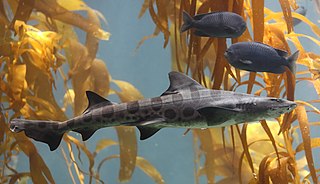
The leopard shark is a species of houndshark, in the family Triakidae. It is found along the Pacific coast of North America, from the U.S. state of Oregon to Mazatlán in Mexico. Typically measuring 1.2–1.5 m (3.9–4.9 ft) long, this slender-bodied shark is immediately identifiable by the striking pattern of black saddle-like markings and large spots over its back, from which it derives its common name. Large schools of leopard sharks are a common sight in bays and estuaries, swimming over sandy or muddy flats or rock-strewn areas near kelp beds and reefs. They are most common near the coast, in water less than 4 m (13 ft) deep.

The parore also known as luderick, black bream, black snapper or blackfish is a species of marine ray-finned fish, a sea chub from the family Kyphosidae which is found in the southwestern Pacific Ocean off Australia and New Zealand. Parore or paraore is the common name in New Zealand but in Australia luderick is preferred.

The Pacific staghorn sculpin is a species of marine ray-finned fish belonging to the family Cottidae, the typical sculpins. This species is found in the eastern Pacific Ocean. It is the only species in the monospecific genus Lepidocottus.

The Atlantic threadfin is a species of ray-finned fish a threadfin from the family Polynemidae which is native to subtropical and temperate waters of the western Atlantic Ocean and the Gulf of Mexico.

The pelagic thresher is a species of thresher shark, family Alopiidae; this group of sharks is characterized by the greatly elongated upper lobes of their caudal fins. The pelagic thresher occurs in the tropical and subtropical waters of the Indian and Pacific Oceans, usually far from shore, but occasionally entering coastal habitats. It is often confused with the common thresher, even in professional publications, but can be distinguished by the dark, rather than white, color over the bases of its pectoral fins. The smallest of the three thresher species, the pelagic thresher typically measures 3 m (10 ft) long.
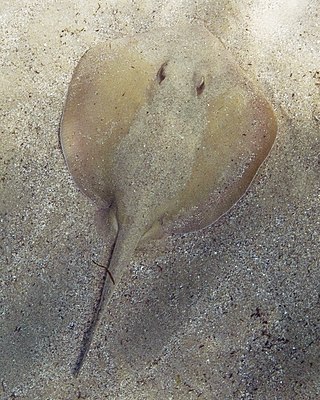
The common stingaree is a species of stingray in the family Urolophidae. The most abundant ray in inshore waters off eastern Australia, it generally inhabits estuaries, sandy flats, and rocky reefs from the shore to a depth of 60 m (200 ft). This plain brownish to grayish species has a rounded pectoral fin disc with a broadly triangular snout. Its nostrils have enlarged lobes on their outer margins and a skirt-shaped curtain of skin with a fringed posterior margin between them. Its tail bears a small dorsal fin before the stinging spine, and terminates in a leaf-shaped caudal fin. This ray can grow to 52 cm (20 in) long.
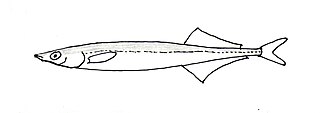
The Korean sandlance is a species of marine ray-finned fish belonging to the family Hypoptychidae. The Korean sandlance is the only species in this monotypic family and genus and is found in the northwestern Pacific Ocean.
Hyperprosopon ellipticum, the silver surfperch, is a species of surfperch native to the eastern Pacific Ocean. This species is also displayed in public aquariums.

Polydactylus sexfilis, the six-finger threadfin or yellowthread threadfin, is a species of marine ray-finned fish, a threadfin from the family Polynemidae which is found in the Indian and Pacific Oceans.

The king threadfin, also known as the blind salmon, blink tassel-fish, burnett salmon, gold threadfin, king salmon, kingfish, Sheridan threadfin, triped tassel fish, or threadfin salmon, is a species of marine ray-finned fish, a threadfin from the family Polynemidae which is found in southern New Guinea and northern Australia.

The Indian threadfin is a species of marine ray-finned fish from the family Polynemidae, the threadfins. It is a coastal species from south-east Asia which has been recorded in Papua New Guinea.

Taractichthys steindachneri, the sickle pomfret, is a species of marine ray-finned fish, a pomfret of the family Bramidae. It is found in the Indian and Pacific Oceans.
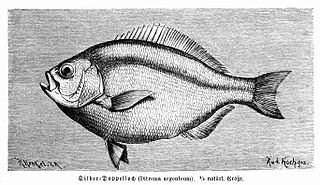
Hyperprosopon argenteum, the walleye surfperch, is a species of surfperch native to the eastern Pacific Ocean.

Embiotoca jacksoni, commonly known as the black surfperch, is a species of surfperches native to shallow coastal areas of the eastern Pacific. Other common names of the species include black perch and butterlips. They are usually a dark reddish brown to tan in color, often also with vertical dark bars across their body. They are commercially important food and game fish.
Polynemus aquilonaris, commonly known as the northern paradise fish, is a fish of the threadfin family Polynemidae. It is native to the large rivers of mainland Southeast Asia.

Polydactylus sextarius, the blackspot threadfin, is a species of marine ray-finned fish, a threadfin from the family Polynemidae which is native to the western Pacific and eastern Indian Oceans.
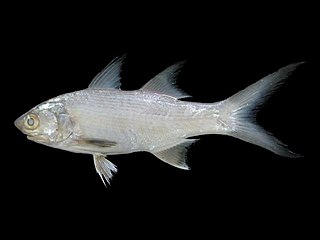
Polydactylus plebeius, the striped threadfin, also known as the common threadfin, Northern threadfin or puttynose, is a species of marine fish native to the Indo-Pacific.
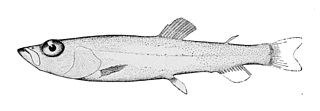
The southern smoothtongue or California smoothtongue is a type of ray-finned fish in the deep-sea smelt family Bathylagidae, that can grow to a length of 15 centimetres (6 in) TL. This fish is native to the northeastern Pacific Ocean from British Columbia to Oregon, and the Gulf of California where it is found at depths of 100 to 850 metres.

The royal threadfin is a species of ray-finned fish, a threadfin from the family Polynemidae, the threadfins. It is found in the eastern Atlantic Ocean along the western coast of Africa.

















